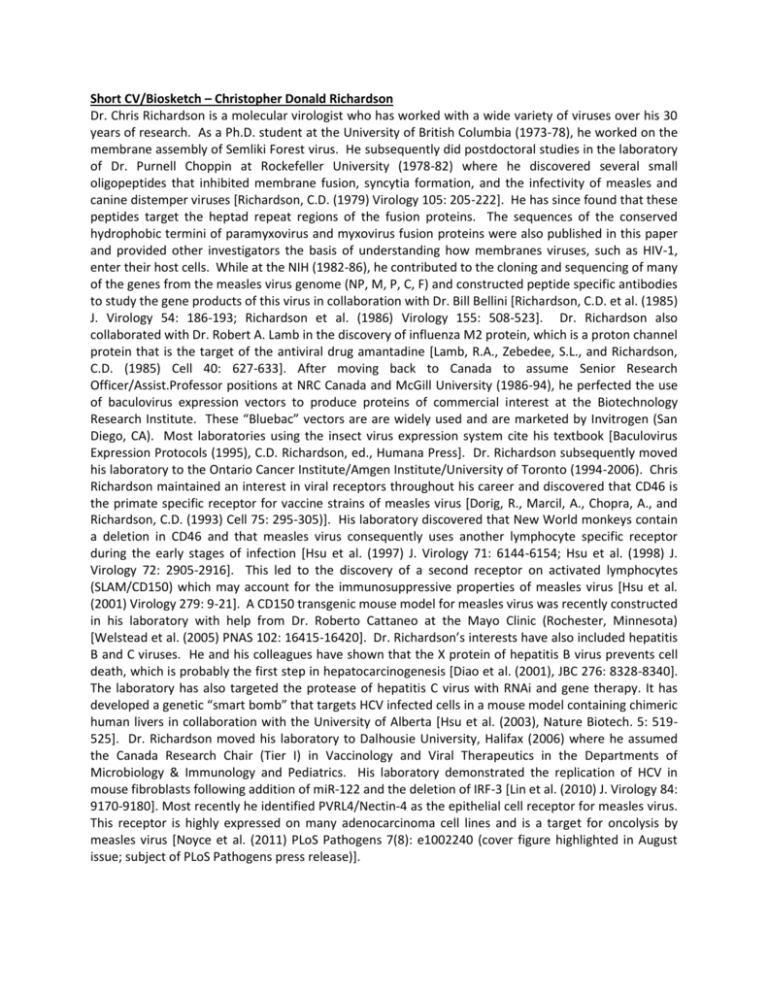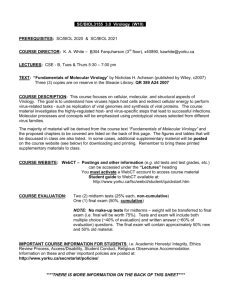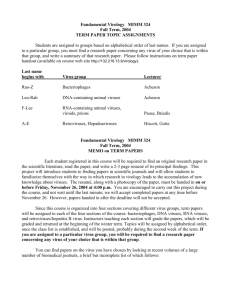Short CV/Biosketch – Christopher Donald
advertisement

Short CV/Biosketch – Christopher Donald Richardson Dr. Chris Richardson is a molecular virologist who has worked with a wide variety of viruses over his 30 years of research. As a Ph.D. student at the University of British Columbia (1973-78), he worked on the membrane assembly of Semliki Forest virus. He subsequently did postdoctoral studies in the laboratory of Dr. Purnell Choppin at Rockefeller University (1978-82) where he discovered several small oligopeptides that inhibited membrane fusion, syncytia formation, and the infectivity of measles and canine distemper viruses [Richardson, C.D. (1979) Virology 105: 205-222]. He has since found that these peptides target the heptad repeat regions of the fusion proteins. The sequences of the conserved hydrophobic termini of paramyxovirus and myxovirus fusion proteins were also published in this paper and provided other investigators the basis of understanding how membranes viruses, such as HIV-1, enter their host cells. While at the NIH (1982-86), he contributed to the cloning and sequencing of many of the genes from the measles virus genome (NP, M, P, C, F) and constructed peptide specific antibodies to study the gene products of this virus in collaboration with Dr. Bill Bellini [Richardson, C.D. et al. (1985) J. Virology 54: 186-193; Richardson et al. (1986) Virology 155: 508-523]. Dr. Richardson also collaborated with Dr. Robert A. Lamb in the discovery of influenza M2 protein, which is a proton channel protein that is the target of the antiviral drug amantadine [Lamb, R.A., Zebedee, S.L., and Richardson, C.D. (1985) Cell 40: 627-633]. After moving back to Canada to assume Senior Research Officer/Assist.Professor positions at NRC Canada and McGill University (1986-94), he perfected the use of baculovirus expression vectors to produce proteins of commercial interest at the Biotechnology Research Institute. These “Bluebac” vectors are are widely used and are marketed by Invitrogen (San Diego, CA). Most laboratories using the insect virus expression system cite his textbook [Baculovirus Expression Protocols (1995), C.D. Richardson, ed., Humana Press]. Dr. Richardson subsequently moved his laboratory to the Ontario Cancer Institute/Amgen Institute/University of Toronto (1994-2006). Chris Richardson maintained an interest in viral receptors throughout his career and discovered that CD46 is the primate specific receptor for vaccine strains of measles virus [Dorig, R., Marcil, A., Chopra, A., and Richardson, C.D. (1993) Cell 75: 295-305)]. His laboratory discovered that New World monkeys contain a deletion in CD46 and that measles virus consequently uses another lymphocyte specific receptor during the early stages of infection [Hsu et al. (1997) J. Virology 71: 6144-6154; Hsu et al. (1998) J. Virology 72: 2905-2916]. This led to the discovery of a second receptor on activated lymphocytes (SLAM/CD150) which may account for the immunosuppressive properties of measles virus [Hsu et al. (2001) Virology 279: 9-21]. A CD150 transgenic mouse model for measles virus was recently constructed in his laboratory with help from Dr. Roberto Cattaneo at the Mayo Clinic (Rochester, Minnesota) [Welstead et al. (2005) PNAS 102: 16415-16420]. Dr. Richardson’s interests have also included hepatitis B and C viruses. He and his colleagues have shown that the X protein of hepatitis B virus prevents cell death, which is probably the first step in hepatocarcinogenesis [Diao et al. (2001), JBC 276: 8328-8340]. The laboratory has also targeted the protease of hepatitis C virus with RNAi and gene therapy. It has developed a genetic “smart bomb” that targets HCV infected cells in a mouse model containing chimeric human livers in collaboration with the University of Alberta [Hsu et al. (2003), Nature Biotech. 5: 519525]. Dr. Richardson moved his laboratory to Dalhousie University, Halifax (2006) where he assumed the Canada Research Chair (Tier I) in Vaccinology and Viral Therapeutics in the Departments of Microbiology & Immunology and Pediatrics. His laboratory demonstrated the replication of HCV in mouse fibroblasts following addition of miR-122 and the deletion of IRF-3 [Lin et al. (2010) J. Virology 84: 9170-9180]. Most recently he identified PVRL4/Nectin-4 as the epithelial cell receptor for measles virus. This receptor is highly expressed on many adenocarcinoma cell lines and is a target for oncolysis by measles virus [Noyce et al. (2011) PLoS Pathogens 7(8): e1002240 (cover figure highlighted in August issue; subject of PLoS Pathogens press release)].






